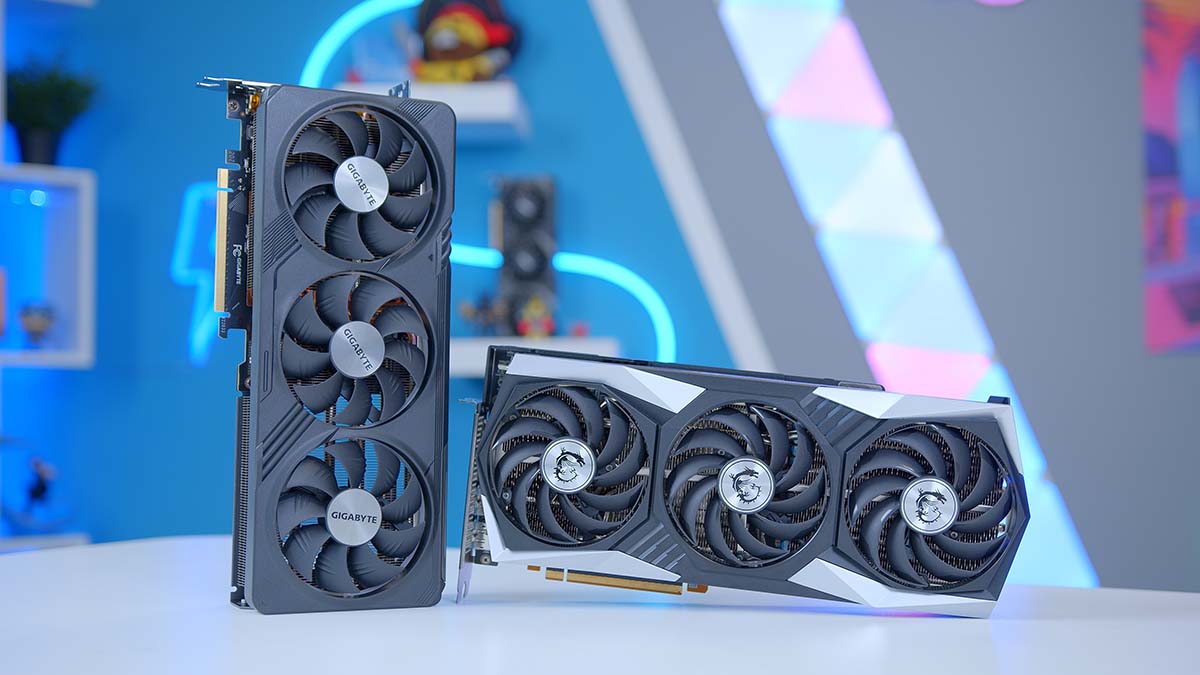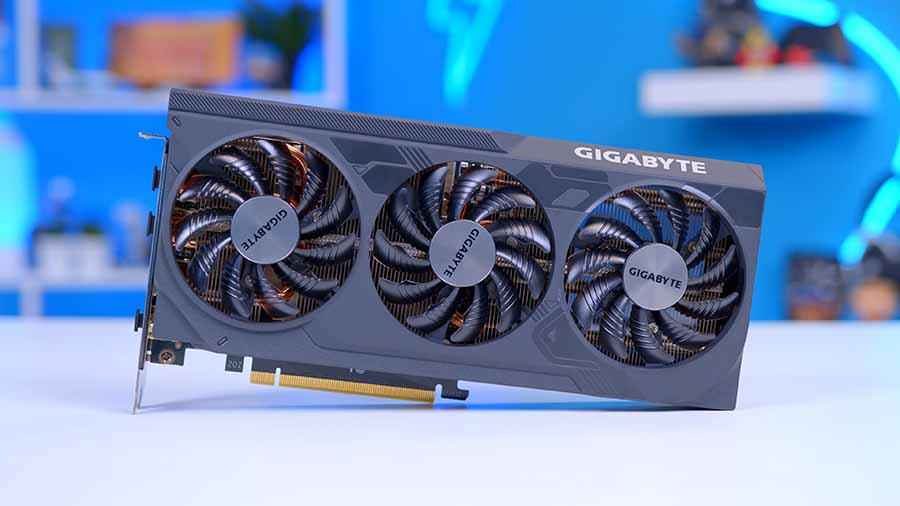Finding a graphics card that offers the performance needed for your favourite games while also sitting under the $700 mark isn’t the most straightforward task. The constantly evolving landscape of the GPU market means that there is a massive range of highly capable cards with extremely competitive prices, which makes choosing the right card a hard decision. To make this easier, we’ve tested the best graphics cards under $700 to determine the best options on the market.
We’ve picked out cards from NVIDIA and AMD, catering to those looking to play games at 1440p and 4K or those needing extra computing power in more challenging workloads. This guide looks at each graphics card’s hardware, features and performance, along with an assessment of the value compared to market alternatives.
The Best Graphics Cards to Buy For Under $700
1. NVIDIA GeForce RTX 4070 SUPER

The RTX 4070 SUPER from NVIDIA is sitting at the top spot for the best graphics card to buy for under $700. It offers a significant performance boost over the discontinued RTX 4070 without deviating from its MSRP of $599. This card marks its territory in the 1440p scene, much like the original RTX 4070. It is arguably the king of the mid-tier market, boasting improvements that easily cater to AAA and Esports titles.
The RTX 4070 SUPER is equipped with 12GB of GDDR6X video memory on a 192-bit memory bus and a core clock speed of 1.98GHz that can boost up to 2.48GHz. Boasting more CUDA, RT, and Tensor cores than the RTX 4070, the RTX 4070 SUPER offers up to a 20% performance boost, putting it close to the 4070 Ti in comparison. Ultimately, the RTX 4070 SUPER delivers exceptional value within the RTX 4000 series, making it one of the best-value NVIDIA GPUs under $700.
| Key Specs | NVIDIA GeForce RTX 4070 SUPER |
|---|---|
| Video Memory Capacity | 12GB GDDR6X |
| Memory Bus | 192-bit |
| Base Clock Speed | 1.98GHz |
| Boost Clock Speed | 2.48GHz |
| CUDA Cores | 7168 |
| RT Cores | 56 |
| Power Draw | 220W |
| MSRP | $599 |
Across our testing, the RTX 4070 SUPER is one of the most robust graphics cards within this roundup, handling 1440p with ease. In games like Starfield and Cyberpunk 2077, the RTX 4070 SUPER reached 88FPS and 102FPS with Ray Tracing and DLSS enabled.
However, the RTX 4070 SUPER isn’t without its limitations. The primary concern lies in its VRAM capacity; with 12GB of video memory, it falls short by 4GB compared to its direct competitor, the RX 7800 XT, which is priced lower. While currently sufficient for most titles, with games coming with increasing VRAM demands, this may challenge the RTX 4070 SUPER’s longevity, potentially impacting its performance in future game releases.


2. AMD Radeon RX 7800 XT

The AMD Radeon RX 7800 XT offers exceptional 1440p gaming performance at an astounding price of only $499. As one of AMD’s most compelling releases, the RX 7800 XT is ideal for gamers looking to maximise their gaming performance without stretching their budget.
The card boasts 16GB of GDDR6 video memory on a 192-bit bus and can hit core and boost clock speeds of 2.12GHz and 2.4GHz, respectively. The 7800 XT is loaded with 3840 stream processors, 60 ray accelerators and 120 AI accelerators, allowing for excellent performance for its price point.
This card’s 16GB VRAM advantage over cards like the RTX 4070 SUPER offers immediate benefits in intensive AAA games and ensures longevity as future titles become more demanding. Priced at $499, its cost-effectiveness for 1440p gaming is unparalleled, presenting a great option for gamers looking for performance with future-proofing in mind.
| Key Specs | AMD Radeon RX 7800 XT |
|---|---|
| Video Memory Capacity | 16GB GDDR6 |
| Memory Bus | 192-bit |
| Base Clock Speed | 2.12GHz |
| Boost Clock Speed | 2.4GHz |
| Stream Processors | 3840 |
| Ray Accelerators | 60 |
| Power Draw | 263W |
| MSRP | $499 |
Regarding rasterised gaming performance, the RX 7800 XT is one of the best graphics cards on the market. During our benchmarking, the RX 7800 XT established itself as a solid competitor in games like Cyberpunk 2077 and Hogwarts Legacy at 1440p with 103FPS and 102FPS averages, respectively.
However, the RX 7800 XT does fall short in one notable area: ray tracing. Despite its strengths, AMD’s offering lags behind NVIDIA’s in terms of ray tracing capabilities, translating to weaker performance in games that utilise this technology. Gamers keen on experiencing the best ray traced visuals might need to consider one of the NVIDIA alternatives.


3. NVIDIA GeForce RTX 4070

The NVIDIA RTX 4070 has adjusted to a new market reality with a revised MSRP of $499, further solidifying its position as a compelling choice for those looking to buy a GPU for under $700. Amid the RTX 4000 series’ varied reception, the RTX 4070 stands out by offering a balanced mix of performance and price, now more accessible thanks to its price adjustment following the release of the RTX 4070 SUPER.
With 12GB of GDDR6X memory, a 192-bit memory bus, and clock speeds peaking at 2.48GHz, the RTX 4070 is built to handle demanding gaming workloads at both 1440p and even 4K. It boasts 5888 CUDA cores and 46 RT cores, meaning it’s still a viable option, even when compared to the SUPER variant.
| Specification | NVIDIA GeForce RTX 4070 |
|---|---|
| Video Memory Capacity | 12GB GDDR6X |
| Memory Bus | 192-bit |
| Base Clock Speed | 1.92GHz |
| Boost Clock Speed | 2.48GHz |
| CUDA Cores | 5888 |
| RT Cores | 46 |
| Power Draw | 200W |
| MSRP | $499 |
Across our testing, the RTX 4070 has proven highly capable at 1440p in modern games. We saw strong averages of 87FPS and 85FPS from the RTX 4070 in both Cyberpunk 2077 and Hogwarts Legacy, which are graphically demanding titles.
The primary concern for the RTX 4070 lies in its VRAM capacity; with 12GB of GDDR6X, it may lag behind competitors offering more memory, potentially impacting gaming performance in future releases.


How We Tested the Best Graphics Cards Under $700
We require a large amount of data to provide solid product recommendations. This is why our graphics cards are tested rigorously and methodically to ensure we have a big data set to compare and consolidate which graphics cards are worth recommending. All our cards are tested at three different resolutions at varying settings within AAA and Esports titles to ensure we have a full suite of current and relevant benchmarks. To ensure that all of our testing is fair and repeatable, we’ve published a full rundown of our settings in a How We Test Graphics Cards article.
Hogwarts Legacy
Settings: 1440p, Shadow Quality High, Indirect Lighting High, Reflections High, Crowd Density High, Particle Quality High, Volumetric Lighting High, Motion Blur off, GTAO Quality High, Grass Quality High, Contact Shadows High VSync Off, DLSS/FSR: On/Off, Ray Tracing: On/Off, Textures: High
In Hogwarts Legacy, results were tightly packed together, with the RTX 4070 SUPER leading with 104FPS and the RX 7800 XT following closely behind with 102FPS. Admittedly, the RTX 4070 does fall short by about 17FPS or so, with an 85FPS average, but considering how demanding Hogwarts Legacy is at 1440p, we were happy with the performance.

Cyberpunk 2077
Settings: 1440p, Shadow Quality High, Indirect Lighting High, Reflections High, Crowd Density High, Particle Quality High, Volumetric Lighting High, Motion Blur off, GTAO Quality High, Grass Quality High, Contact Shadows High VSync Off, DLSS/FSR: On/Off, Ray Tracing: On/Off, Textures: High
Moving onto Cyberpunk 2077, results here were quite close, but both the RTX 4070 and RTX 4070 SUPER definitively came out on top when ray tracing was switched on. While the RX 7800 XT beat out the NVIDIA options in rasterised gameplay, with a 103FPS average, it falls short when ray tracing is switched on, dropping to 23FPS. The RTX 4070 and RTX 4070 SUPER offered better performance across rasterised and ray traced gameplay, demonstrating that NVIDIA cards are a better option for those playing games with ray tracing enabled.

Starfield
Settings: 1440p, Shadow Quality High, Indirect Lighting High, Reflections High, Crowd Density High, Particle Quality High, Volumetric Lighting High, Motion Blur off, GTAO Quality High, Grass Quality High, Contact Shadows High VSync Off, DLSS/FSR OFF
In Starfield at 1440p high settings, the results were sitting pretty close together, with the RTX 4070 SUPER leading the fore with 88FPS. However, the RX 7800 XT and RTX 4070 sat at 83FPS and 77FPS, respectively, which isn’t a particularly noticeable loss in performance.

Frequently Asked Questions
Are these Cards Capable of 4K Gaming?
All GPUs in this roundup can play games at 4K, but framerates will vary depending on how demanding each title is.
Is DLSS Better than FSR?
While FSR has come a long way, and there are a vast number of games that support it, DLSS is just better overall and more refined.
Are Founders and Reference Models Worth It?
Yes, they are. Although these cards may be slightly weaker thermally, they’re often cheaper than their respective AIB counterparts.







![FI_[DM82] TT MineCUBE Build](https://geekawhat.com/wp-content/uploads/2025/12/FI_DM82-TT-MineCUBE-Build-551x431.jpg)
![FI_[DP056] Antec flux M + 9060XT](https://geekawhat.com/wp-content/uploads/2025/12/FI_DP056-Antec-flux-M-9060XT-551x431.jpg)



